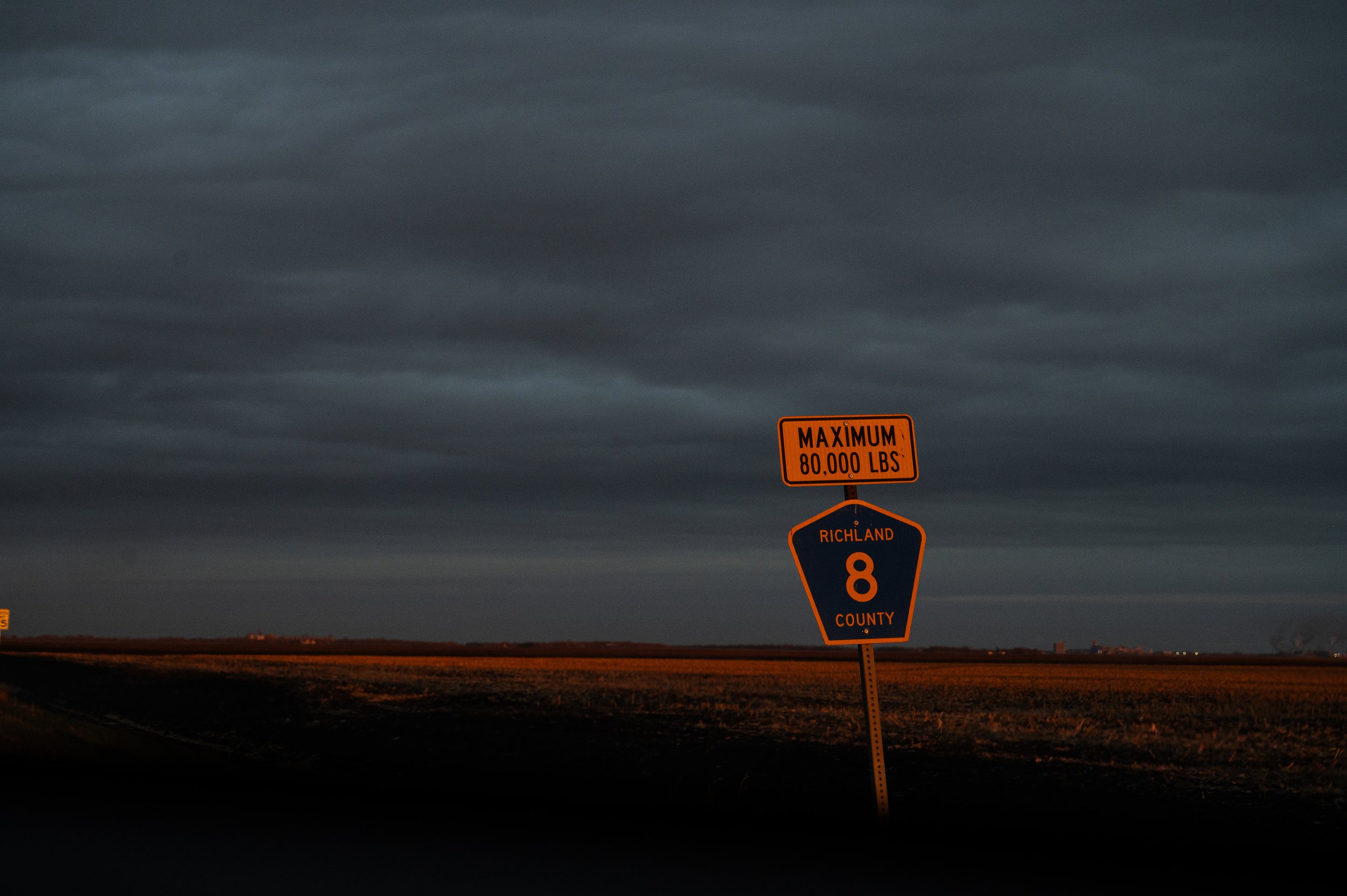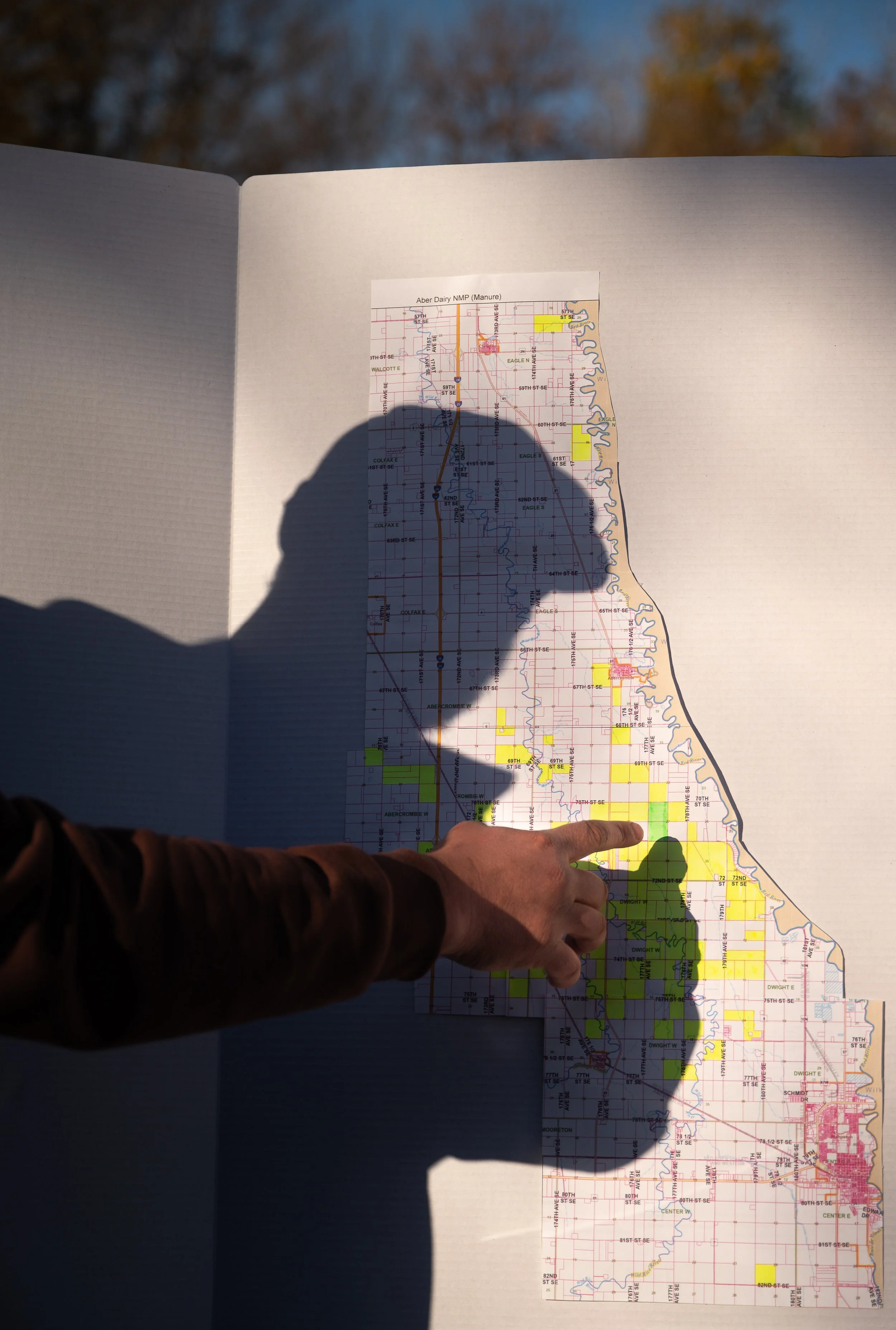‘We Take Last Place’: North Dakota Residents Fight Industrial Dairy Threat to Land and Legacy
Mary and David Stahl on their family farm.
In the wide open farmland outside the quiet town of Abercrombie, ND, generations of families have built lives reliant on the health of the surrounding land. But today, many of them are staring down a future that feels like it’s being written without them—one where industrial agriculture takes priority over people, and water, air, and farmland are left at risk.
Just outside Abercrombie, in between the Red and Wild Rice rivers, a 12,500-head corporate dairy operation is slated to break ground. The company behind it, Riverview LLP, has already signaled plans to expand to 19,000 cows. Residents like Mary and David Sahl, whose family has farmed this land since the 1800s, fear it may be the end of their way of life.
“The first thing that ran to our minds is that's a lot of cows, that's a lot of manure,” Mary said. “We’re concerned about well use, and we’re concerned about well contamination.”
Riverview LLP, which already operates large dairies across Minnesota and other states, has become a symbol of the shift from small, family-run farms to massive corporate-controlled factory farms.
“Factory farming issues are something that have affected my life quite substantially,” said Matthew Sheets, a community organizer with the Land Stewardship Project from Morris, Minnesota. “Where I live is the home of one of the largest dairy operations in the country—Riverview Dairy. As of 2018, they had about 125,000 head of cattle in Minnesota, and they've only expanded since then.”
The economic power of such operations is deeply tied to their scale, Matthew noted. “They have such an economy of scale that they’re still making money when milk prices dip to $10 a hundredweight, while most small dairy farmers can’t survive if it's below $20. Every dip in the market pushes out more and more family farms. We still have roughly the same number of cows in Minnesota as we did in the 1980s, but way fewer people farming them.” The town of Morris saw the loss of 1,100 family dairies from 2012-2017 alone while Riverview continued to grow its operation.
A photo of Mary’s parents with crates of chicks.
Residents in North Dakota fear a similar fate if the Abercrombie facility is built. Mary and Dave worry most about what this will do to the last remaining small dairies in North Dakota. In 2023, North Dakota enacted House Bill 1371, significantly altering its longstanding corporate farming restrictions to promote growth in the animal agriculture sector. This legislation permits corporations and limited liability companies to own or lease farmland specifically for livestock operations, provided they meet certain criteria: entities must have no more than ten shareholders or members, with at least 75% (for corporations) or 51% (for LLCs) actively engaged in farming or ranching. Additionally, ownership is capped at 160 acres per operation, and all shareholders must be U.S. citizens.
While proponents argue that this "modernization" facilitates capital investment and revitalizes rural communities, critics express concern that it paves the way for large-scale industrial agriculture to dominate, potentially undermining small, family-run farms. By allowing corporate entities to be classified similarly to traditional agricultural operations, these businesses may benefit from tax exemptions and other advantages originally intended for family farms. This shift raises questions about the long-term impacts on rural economies, environmental sustainability, and the preservation of community-centered farming traditions. “There are 22 small dairies left in the state,” Mary said. “We talked to a couple of them. They said, flat out, this will wipe us out.”
The prospect of a large confined animal feeding operation (CAFO) brings not only concerns about market consolidation but also water quality, odor, traffic, and environmental degradation.
Environmental Concerns
They have every reason to be concerned. North Dakota’s agricultural laws offer little protection for rural residents when it comes to massive CAFOs like this one. There are no requirements to monitor private wells, no guarantees to replace contaminated water, and no contingency plans if local aquifers run dry.
The CAFO is proposed to go between the Red and Rice rivers.
“When I asked what would happen if our well goes dry—I have concerns because I’m battling breast cancer—the guy just looked at me and said, ‘Get rural water,’” Mary said when asking X about the CAFO’s water use. “We don’t have rural water. We have a good well—a new well—and it costs a lot to put in rural water. That’s why everyone around here is still on wells.”
David didn’t mince words: “We take last place. The cows get priority over us.”
Residents have pored over hydrology reports and environmental assessments. What they’ve found is alarming: clay liners used in manure lagoons can leak, nitrate-rich runoff from fertilized fields will likely seep into the water table, and neither the state nor the company is required to act if contamination occurs.
“Everyone says, ‘Oh, this clay is impermeable.’ It’s not,” David said. “We’ve hired hydrologists. We’ve done the research. But no one wants to slow down and look at it.”
Abercrombie residents, Dylan Johnson and Caitlin Johns live just a mile from the proposed site. “They’re going to be using 300,000 to 500,000 gallons of water a day,” Dylan said. “This isn’t a thing that’s just here for 10 years. It’s gonna be here forever.”
His family has been on this land for over a century. “I gotta worry about my kids and their kids in the future, because this will all get handed down to them,” Dylan said.
Dylan Johnson driving through the area where the CAFO is proposed to go in.
In Minnesota, Matthew has seen firsthand the environmental toll of CAFOs. “The manure from large operations like this isn’t the same as what you get from grazing cattle or pigs. It’s stored in pits where it ferments and becomes highly toxic and concentrated. That kind of liquid manure tends to run off into streams and seep into aquifers—especially in areas with porous geology, which we have here, and you have in parts of North Dakota, too.”
Matthew Sheets, Land Stewardship Project.
He recalled a Riverview proposal near his family’s farm that was ultimately blocked after a water study showed it would draw down the aquifer to just 25% in eight years. “These operations are massive water users. If you’re drawing millions of gallons from an aquifer every year, that’s not sustainable for the community or the ecosystem.”
Adding to community frustration is the influence Riverview has over local government. “Three out of five county commissioners had a connection to Riverview. That’s the kind of power we’re up against,” Matthew said. “Even when everyone in the community agrees on opposing a project, that doesn’t mean we win. But when we do—when we apply enough pressure—it’s really gratifying.”
Back in North Dakota, the proposal near Abercrombie has stirred similar fears, particularly around water usage and manure disposal. Company representatives claim the manure will be available to nearby farmers for use as fertilizer, a strategy also used in Minnesota. But Matthew warned this arrangement can create long-term dependency.
“The manure often comes with a contract,” he explained. “Farmers grow silage corn for Riverview and receive manure in exchange. The contract guarantees income and fertilizer, which sounds good—but it binds farmers to the CAFO. It’s a clever way to capture hearts and minds. But it’s not always good for the land or the long-term independence of the farmer.”
Farmers in North Dakota are also vulnerable to one-sided relationships with the company. “There are no written contracts for the farmers,” Mary explained. “They just shake your hand and walk away if they don’t want your crop.” Mary called up a farmer in Minnesota and asked how the deal with the CAFO worked out for him. To which he replied, not at all. The farmer tried for two years to grow the type of corn requested by the CAFO, a high sugar corn that is used for silage but not for regular harvest. She explained that a farmer can go through the time and financial expense to grow the silage corn all for the CAFO to say, no and walk away.
Cultural Loss
Caitlin Johns and Dylan Johnson.
The environmental risks are only one part of the story. Caitlin Johns, another Abercrombie resident, said the industrial dairy threatens the very culture of the community.
“We’re a tight-knit community,” she said. “Family farms, family-oriented. We’re not into big commercial farming. That’s not who we are.”
Caitlin and her husband worry about air quality, especially for their children and the town’s elementary school. “Are they going to be able to go outside most days? Without breathing in all the pathogens floating in the air?”
While the company claims the facility will bring economic benefits, Caitlin sees it differently. “Riverview has their own crews. They’re not going to hire local. And our schools are already underfunded—we struggle to get teachers as it is. If they’re not paying taxes, who’s going to support the growth they’re causing?”
And the milk? “It’s being made into cheese and shipped to other places,” she said. “Nothing about this is rooted in the community.”
Ultimately, Matthew said, the rise of factory farms like Riverview represents a deeper threat to rural life and food systems. “Twenty thousand cows in one place could support 200 to 400 family farms. But now, all that wealth and all those resources are in the hands of one corporation. If we keep capitulating to a system that hollows out our communities and pushes out the people who care about the land—we’re going to lose more than just farms. We’ll lose the soul of our towns.”
THE FIGHT CONTINUES
Still, amid the uncertainty, something powerful has emerged: solidarity. “We’ve all gotten a lot closer,” Mary said. “It feels good to know that you have the support of your neighbors. They have principles. We’re in this together.”
Local residents are working with Dakota Resource Council to organize, attend ag task force meetings, and demand stronger water protections. “I do feel like I have a voice now,” Mary said. “There’s someone out there who’s listening. There’s someone out there who cares.”
But the odds remain steep. “Abercrombie is growing,” David said. “There’s new houses going up just north of town—what happens to that development when the south wind brings the smell of 19,000 cows with it?”
And he fears this is only the beginning. “Everything that’s going to happen with this corporate farming is going to be along the east part of North Dakota, where all the people live. And yet nobody listens to those people anymore.”
Dylan echoes that urgency. The fight over industrial dairies in North Dakota is far from over. A building and DEQ permit have already been issued for the Abercrombie facility, and a new permit request is underway for a 25,000-head operation in Traill County. Legislation like SB2175, which would implement an odor management tool modeled after those in neighboring states, could make it easier to permit these projects in tighter spaces—raising new concerns for rural communities. For now, water access remains a major hurdle. Residents report test wells being dug near Abercrombie, though it’s unclear whether the proper permits are in place, and some worry that developers may be using shell companies to obscure who actually controls the water. As the debate continues, North Dakotans are left to question who these developments truly serve—and what’s at stake if they move forward unchecked. “I’m not just looking out for myself. I’m looking out for the future residents around here.”









